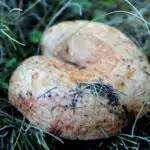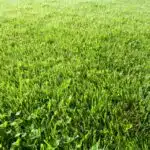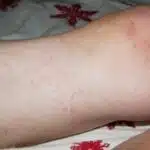Watermelons are a delicious fruit enjoyed by many during the warm summer months. However, accidents can happen and watermelon stains can quickly ruin clothing or upholstery. As a cleaning expert, I understand the importance of removing tough stains quickly and effectively to maintain the appearance of your belongings. In this article, I will provide five simple steps to remove watermelon stains and restore your items to their original state.
Step one involves removing any excess pulp or seeds from the stained area. Step two requires blotting the stain with a clean cloth and cold water to prevent it from setting in further. Step three includes creating a cleaning solution using common household products that can be applied to the stain. Step four involves allowing the solution to sit on the stain for a designated amount of time before rinsing it off with cold water. Finally, step five focuses on drying the item properly to ensure no remaining moisture causes mold or mildew growth. By following these steps, you can effectively remove watermelon stains and preserve your belongings for future use.
Assessing The Stained Area
Effective stain removal starts with assessing the stained area. Before you begin any cleaning process, it is important to identify the extent of the damage and the type of fabric affected. This will help you determine the most appropriate method for removing the stain without causing further damage to your clothing or furniture.
It is also crucial to consider fabric compatibility when assessing watermelon stains. Some fabrics are more delicate than others and require special attention during cleaning. For instance, silk and wool may require a gentler approach compared to cotton or polyester. Failure to take into account fabric compatibility can result in discoloration or even damage to your clothes.
To assess effectiveness, start by testing any cleaning solution on an inconspicuous area of your clothing or furniture. This will help you determine whether the solution is suitable for that particular fabric and whether it will cause any adverse effects such as discoloration or fading. Once you have determined that a cleaning solution is suitable, proceed with confidence knowing that your choice will be effective in removing watermelon stains while preserving your fabric’s integrity.
Gathering Materials For Stain Removal
Ah, the joys of summertime. Nothing beats biting into a juicy watermelon on a hot day, but what about when that sweet red juice ends up all over your favorite shirt? Fear not, my fellow clean freaks! With the right materials and some quick thinking, you can easily remove those pesky watermelon stains.
First and foremost, let’s talk stain removal hacks. Did you know that white vinegar is one of the most versatile DIY cleaning solutions out there? Not only is it cost-effective, but it’s also eco-friendly and safe to use around children and pets. Another pro tip: don’t be afraid to mix up your own cleaning solution using common household items like baking soda or hydrogen peroxide. It may take a little trial and error to find what works best for your specific stain, but trust me, it’s worth it.
Now that we’ve covered the basics of DIY cleaning solutions, let’s focus on gathering the necessary materials for tackling watermelon stains. You’ll want to grab some paper towels or a clean cloth to blot away as much excess juice as possible before attempting any further cleaning. Additionally, make sure you have access to cold water (hot water can actually set in stains) and some mild dish soap. If you’re feeling extra prepared, keep a few stain remover pens or wipes in your purse or car for emergencies.
With our materials at the ready and our DIY knowledge in tow, we’re well-equipped to tackle those stubborn watermelon stains head-on. But where do we begin? Step one involves removing any excess pulp and seeds from the garment before applying any cleaning solution. This helps prevent further staining or damage while allowing us to focus solely on the affected area. Let’s dive in!
Step One: Removing Excess Pulp And Seeds
Removing watermelon stains can be a daunting task, but it doesn’t have to be. The first step is to remove any excess pulp and seeds from the stained area. This can be done by using a spoon or dull knife to gently scrape away any remaining bits of watermelon. Be sure not to rub the stain, as this will only spread it further.
Using vinegar is an effective method for removing watermelon stains. Mix equal parts of white vinegar and water and apply it directly to the stain. Let the solution sit for five minutes before blotting it up with a clean cloth. Repeat this process until the stain disappears.
If you don’t have vinegar on hand, there are alternative methods you can try. One option is to mix baking soda with water to create a paste. Apply the paste to the stain and let it sit for 10-15 minutes before rinsing it off with cold water. Another option is to use hydrogen peroxide by applying a small amount directly onto the stain and leaving it for 5-10 minutes before rinsing with cold water.
Now that we’ve removed any excess pulp and seeds, as well as treated the stain with either vinegar or an alternative method, we’re ready for step two: blotting the stain with cold water. By following these simple steps, your watermelon stain will be a thing of the past in no time!
Step Two: Blotting The Stain With Cold Water
After removing excess pulp and seeds from the watermelon stain, it’s time to move on to the next step of the process. Using a blotting technique with cold water can help remove any remaining residue from the surface of the fabric. This will make it easier for you to tackle the stain itself without having to deal with any additional obstacles.
To start, wet a clean cloth or paper towel with cold water. Make sure that the cloth is not dripping wet, but rather damp enough to be able to absorb any remaining juice or residue. Then, gently blot the stain with the damp cloth, taking care not to scrub too hard or push the stain further into the fabric. Keep blotting until you’ve removed as much of the stain as possible.
If there is still some residual staining left after using vinegar and blotting technique, it’s important to understand the importance of temperature in removing stains. Heat can set certain types of stains permanently into fabrics while cold temperatures can break them down and make them easier to remove. Therefore, when dealing with a stubborn watermelon stain, avoid using hot water or putting it in a dryer since both can cause permanent damage to your clothes or linens. Instead, try repeating Steps One and Two again before moving on to other cleaning methods.
Understanding The Importance Of Temperature
Effective temperature management is crucial when it comes to removing stubborn stains on fabrics. Temperature plays a significant role in the effectiveness of stain removal, especially for watermelon stains. These stains are often tough to get out because they contain natural dyes that can bond with fibers and cause discoloration.
When dealing with watermelon stains, it’s important to use the right temperature for cleaning. For instance, hot water can set the stain and make it more difficult to remove, while cold water might not be strong enough to break down the pigment. Therefore, using warm or lukewarm water is optimal for removing these types of stains as it helps dissolve the pigment without setting it.
Temperature control is also essential when drying fabrics after cleaning. If you dry your clothes under high heat after washing them, you risk setting any remaining stains permanently into the fabric. Therefore, it’s wise always to read care labels and follow manufacturer guidelines on recommended dryer settings for different types of fabrics. Effective temperature management is key in ensuring successful stain removal and maintaining garment quality.
With an understanding of how temperature affects stain removal, we can now move on to step three: creating a cleaning solution that will help break down the remaining pigments in the stain.
Step Three: Creating A Cleaning Solution
Moving on to step three, we’ll be creating a cleaning solution that will help remove those pesky watermelon stains. The first alternative solution is to use white vinegar and baking soda. Simply mix equal parts of both in a bowl until it forms a paste. Apply the paste onto the stain and let it sit for at least 30 minutes before rinsing with cold water.
Another homemade cleaner that may work is using lemon juice and salt. Cut a lemon in half and sprinkle salt onto one of the halves. Rub the salted lemon onto the stain until it’s saturated, then rinse with cold water. Lemon juice is known for its natural bleaching properties, which can help lift stubborn stains.
When choosing the right cleaning products, it’s important to choose ones that are specifically designed for removing fruit stains. Look for products that contain enzymes or oxygen bleach as these are effective at breaking down organic matter such as fruits. Avoid using harsh chemicals or bleach-based cleaners as they can damage the fabric or leave behind residue.
Remember to always test a small, inconspicuous area of the fabric before applying any cleaning solution to ensure it won’t cause any damage or discoloration. By following these steps, you’ll be able to effectively remove those pesky watermelon stains and restore your fabric back to its original state!
Choosing The Right Cleaning Products
When it comes to removing watermelon stains, choosing the right cleaning products is essential. While some may opt for harsh chemicals, it’s important to consider eco-friendly options that won’t harm the environment or your health. There are plenty of natural cleaning solutions that can effectively remove watermelon stains without causing any damage.
Choosing eco-friendly products is not only better for the planet, but it can also be more cost-effective in the long run. Many natural cleaning solutions can be made from ingredients you already have at home, such as vinegar and baking soda. These products are not only effective at removing stains but are also gentle on fabrics and surfaces.
Using natural cleaning solutions doesn’t mean sacrificing effectiveness. In fact, many people find that these options work just as well, if not better than their chemical counterparts. So whether you’re dealing with a tough watermelon stain or simply looking to make your cleaning routine more sustainable, consider opting for eco-friendly products and natural cleaning solutions.
With the right cleaning products in hand, it’s time to move on to applying the solution to the stain. But before diving into this step, it’s important to take a moment to ensure you have all of the necessary materials and tools on hand. Make sure you have a clean cloth or sponge and enough of your chosen cleaning solution to cover the entire stain area.
Step Four: Applying The Solution To The Stain
After mixing the cleaning solution, it is now time to apply it to the watermelon stain. It is important to do this step carefully to avoid spreading the stain further or damaging the fabric. First, dip a clean white cloth into the solution and gently blot the stain, starting from the outer edges and working your way towards the center. Avoid rubbing or scrubbing as this can push the stain deeper into the fabric.
If you are dealing with a large or stubborn stain, you may need to repeat this process several times until you see some improvement. Remember that patience is key when removing stains, especially those caused by fruits like watermelon which contain natural dyes that can be difficult to remove. For best results, follow each application of cleaning solution with a rinse using cool water and allow the fabric to air dry.
Stain prevention is always better than cure, so make sure to take steps to protect your fabrics from watermelon stains in the first place. One way to do this is by wearing an apron when cutting or eating watermelon, especially if you are wearing light-colored clothing. You can also try placing a towel or napkin under your plate while eating to catch any drips before they hit your clothes. And if a spill does occur, act quickly and pre-treat the stain as soon as possible using one of our recommended cleaning solutions.
- Sub-list 1: Consider using a laundry detergent with enzymes designed specifically for removing fruit stains.
- Sub-list 2: Try mixing equal parts white vinegar and water in a spray bottle and spraying directly onto the stain before washing.
- Sub-list 3: For particularly stubborn stains, mix baking soda with enough water to form a paste and apply it directly onto the affected area before washing as usual.
Understanding the importance of dwell time is crucial when it comes to effectively removing tough stains like those caused by watermelon juice. Dwell time refers to how long you allow a cleaning solution to sit on a stain before rinsing or washing it away. In general, the longer you can allow the solution to penetrate the fibers of the fabric, the better your chances of removing the stain completely. So, after applying your cleaning solution, be sure to give it enough time to work its magic before rinsing thoroughly with cool water.
Understanding The Importance Of Dwell Time
Dwell time is an important factor in effective cleaning and stain removal. Selecting the right product for the type of fabric and stain is essential for optimal results. Pre-treating and blotting are two effective methods to prepare a fabric for cleaning. Scrubbing, soaking, and using the correct water temperature are important considerations when using a detergent or stain remover. Washing machines can provide a more efficient clean when dealing with large stains, however, attention must be paid to the type of cloth being cleaned. Finally, to reduce the amount of stains that occur, a preventative approach such as spot treating is recommended.
Dwell Time
As a cleaning expert, I understand the importance of maximizing dwell time when removing tough stains like watermelon. Dwell time refers to the period where the cleaning solution is left on the surface before wiping or rinsing it off. It allows the solution to penetrate and break down stains, making them easier to remove.
One common mistake during dwell time is not allowing enough time for the cleaning solution to work. Some people tend to rush and wipe off the solution immediately after applying it, which reduces its effectiveness. To maximize dwell time, it’s essential to follow the instructions on the cleaning product label and leave it for the recommended period.
Another mistake is using too much cleaning solution during dwell time. Applying an excessive amount of cleaning solution won’t necessarily speed up the process but may damage or discolor surfaces. Therefore, it’s important to use a moderate amount of cleaning solution and let it sit for long enough to do its job effectively.
By understanding the importance of maximizing dwell time and avoiding common mistakes during this crucial step of stain removal, you can ensure that your watermelon stains are removed efficiently without damaging your surfaces. Remember that patience is key when dealing with stubborn stains!
Cleaning
As a cleaning expert, I know that removing wine stains and preventing food stains can be challenging tasks. One crucial factor in effective stain removal is understanding the importance of dwell time. Dwell time refers to the period where the cleaning solution is left on the surface before wiping or rinsing it off. It’s a critical step in stain removal because it allows the solution to penetrate and break down stains, making them easier to remove.
When it comes to removing wine stains, maximizing dwell time is crucial. Wine contains tannins that can quickly set into fabrics, making them difficult to remove. Therefore, it’s essential to let the cleaning solution sit for an adequate amount of time before attempting to clean the stain. Applying too much pressure or scrubbing too vigorously while removing wine stains can damage delicate fabrics like silk and wool.
Preventing food stains from setting in also requires maximizing dwell time. When dealing with food spills on carpets or upholstery, it’s essential to act fast and blot up as much of the spill as possible before applying any cleaning solutions. Once you’ve applied your cleaning solution, let it sit for at least 10-15 minutes before attempting to clean the area further. This will allow enough time for the solution to penetrate and break down any remaining stain particles effectively.
By understanding how important dwell time is when removing wine stains and preventing food stains from setting in, you can ensure that your surfaces remain spotless and free from stubborn stains. Remember always to follow the instructions on your cleaning product label carefully and avoid rushing through this critical step of stain removal!
Stain Removal
Stain removal is an essential aspect of cleaning that homeowners should master. Stains can be caused by various substances such as food, drinks, and even pets. Removing stains can be challenging, especially if they have set in for a long time. However, understanding the importance of dwell time can make a significant difference in stain removal. Dwell time refers to the duration that a cleaning solution remains on the surface before wiping or rinsing it off.
One of the prevention tips for stain removal is to act fast when dealing with spills. The longer you wait, the harder it becomes to remove the stain. As soon as you notice a spill, grab a clean cloth and blot up as much liquid as possible. Avoid rubbing or scrubbing because this can push the stain deeper into the fabric or carpet fibers. Once you’ve blotted up all the excess moisture, apply your cleaning solution according to instructions on the label.
In addition to prevention tips, DIY remedies can also help with stain removal. For instance, baking soda and vinegar are effective natural cleaners for removing tough stains like blood and red wine. To use this remedy, mix equal parts of baking soda and water to form a paste and apply it directly on the stained area. Let it sit for at least 30 minutes before washing it off with vinegar mixed with water. By incorporating these prevention tips and DIY remedies into your cleaning routine, you can keep your home looking spotless and free from stubborn stains!
Rinsing The Stain With Cold Water
After identifying the watermelon stain on the item, it is important to rinse it immediately with cold water. Cold water has several benefits in removing stains, particularly fruit stains like watermelon. Firstly, cold water helps prevent the stain from setting into the fabric or surface of the item. Secondly, it can effectively dilute and loosen the stain without damaging the material.
To rinse a watermelon stain with cold water, start by holding the item under a running faucet or submerging it in a bowl of cold water. Make sure to use enough pressure to flush out as much of the stain as possible without rubbing or scrubbing it. The key is to allow the cold water to do its job by gently washing away any excess juice or pulp that may be left on the surface.
Watermelon stain prevention is also important in maintaining clean surfaces and fabrics. To prevent future stains from occurring, avoid placing items near exposed fruits or designate specific areas for eating and drinking. Additionally, using protective coverings such as tablecloths or placemats can help reduce contact between fruit juices and surfaces prone to staining.
After rinsing with cold water thoroughly, move onto step five: drying the item properly. It is crucial to remove all excess moisture before storing or using an item again.
Step Five: Drying The Item Properly
Proper Drying is the final step in eliminating watermelon stains effectively. It is important to ensure that the item is completely dry before storing it. Even a small amount of moisture can lead to mildew growth, which can cause further damage to the fabric or surface.
To properly dry an item, first remove any excess moisture with a clean cloth. Then, allow the item to air-dry in a well-ventilated area. Avoid using heat sources such as hairdryers or heaters as they can cause shrinkage, discoloration or other damage to the fabric.
Preventing Mildew is crucial in ensuring that your items do not get damaged. One way to prevent mildew growth is by using a fan or dehumidifier in the room where you are drying the item. This helps circulate air and reduces moisture levels. Additionally, make sure that the item is completely dry before putting it away. If you notice any signs of mildew growth such as a musty smell or black spots on the fabric, take immediate action to prevent further damage.
Transition: While Proper Drying and Preventing Mildew are essential steps in removing watermelon stains, there are still common mistakes that people make when dealing with stains. In our next section, we will discuss these mistakes and how to avoid them for effective stain removal.
Avoiding Common Mistakes In Stain Removal
Effective stain removal techniques can be undermined by common stain removal mistakes. It is essential to avoid these mistakes to achieve successful results in removing stubborn stains. One of the most common mistakes is not acting promptly on the stain. The longer a stain sits, the more difficult it becomes to remove.
Another mistake is using hot water on stains that require cold water. For instance, protein-based stains like blood or sweat should be treated with cold water as hot water sets these stains. A third mistake is rubbing the stain too vigorously, which damages the fabric and pushes the stain deeper into it.
To avoid these common mistakes, consider following these four tips:
- Act promptly: The faster you act on a stain, the easier it will be to remove.
- Test cleaning products: Before using any cleaning product, test it on an inconspicuous area of the fabric to ensure it doesn’t cause discoloration or damage.
- Use appropriate temperature: Always use the right temperature for different types of stains and fabrics.
- Blot gently: Never rub a stain too hard; instead, blot it gently to prevent pushing it further into the fabric.
By avoiding common mistakes and implementing effective techniques for removing stains, you can enjoy clean clothes and upholstery without worry. In the next section, we will discuss tips for preventing watermelon stains altogether so that you won’t have to deal with them in the first place.
Tips For Preventing Watermelon Stains
Preventing watermelon stains is always better than dealing with them later. Therefore, it is essential to take some preventive measures while handling this juicy fruit. Firstly, you should avoid cutting the watermelon on a surface that can easily stain. Instead, use a cutting board or a plate for this purpose. You can also place a paper towel over the surface to prevent any spills from staining your countertop.
Secondly, choosing the right container for storing watermelon can also help prevent stains. Always use an airtight container that has a lid and is resistant to leaks. This will prevent any juice from spilling out and staining your refrigerator shelves or other food items stored nearby. Moreover, using sealable plastic bags can also be helpful in preventing spills while carrying sliced watermelons for picnics or other outings.
Lastly, it is crucial to handle watermelons with care when serving them to others. Make sure you provide ample napkins and plates to your guests so that they do not accidentally spill juice on their clothes or other belongings. Additionally, you can offer them serving spoons so that they can take slices of watermelon without having to touch the fruit directly with their hands.
Now that you know some tips for preventing watermelon stains let’s move on to alternative stain removal methods that you can try at home in case of accidental spills and stains.
Alternative Stain Removal Methods
As a cleaning expert, I understand that sometimes even the most trusted stain removal methods may not work effectively. In such cases, it is always helpful to explore natural remedies and DIY solutions that can help you eliminate stubborn stains without damaging your fabrics. These alternative methods are not only effective but also environmentally friendly and wallet-friendly.
One of the best natural remedies for removing tough stains is vinegar. This multipurpose household item is highly acidic, making it an excellent choice for breaking down stains. Simply mix equal parts water and white vinegar, then apply the solution to the stained area with a clean cloth. Allow it to sit for 10-15 minutes before washing the fabric as usual.
If vinegar doesn’t do the trick, you can try using baking soda. This versatile ingredient works wonders on various types of stains, including those caused by food, grease, and oil. Mix a small amount of baking soda with water to form a paste, then apply it directly onto the stain. Let it sit for at least 30 minutes before rinsing off and washing as usual.
When dealing with persistent stains that refuse to budge, don’t give up just yet! In the next section on troubleshooting persistent stains, we will explore more advanced techniques that can help you tackle even the toughest of stains.
Troubleshooting Persistent Stains
Removing stubborn stains can be a daunting task, especially if you have tried everything in the book. However, with the right techniques and proper knowledge, you can become an expert in getting rid of even the most persistent stains. As a cleaning expert, I understand the frustration that comes with trying to remove certain stains, but don’t worry; there are effective techniques that will work.
Preventing stains is always better than treating them. You can do this by being cautious when dealing with items that are prone to staining. For instance, when eating watermelon, use a plate or napkin to catch any juices before they spill on your clothes or carpet. If you accidentally spill something on your clothes or fabric, act fast and blot it out immediately with paper towels or a clean cloth.
Effective techniques for removing stubborn stains include using household products such as vinegar and baking soda. Vinegar is particularly useful for removing food and drink stains while baking soda works well for grease and oil-based stains. It’s important to note that different types of stains require specific techniques for removal. You should always refer to the care label on the fabric before attempting any stain removal technique.
In conclusion, getting rid of persistent stains requires patience and knowledge of effective techniques. By taking preventive measures such as using plates or napkins while eating or drinking and acting fast when spills occur, you can avoid permanent staining. Moreover, using household products such as vinegar and baking soda can go a long way in helping you get rid of stubborn stains effectively.
Conclusion
Watermelon stains can be frustrating to deal with, but with the right approach, they can be easily removed. It is important to first assess the stained area and gather the necessary materials for stain removal. Once you have a plan in place, follow these five simple steps: remove excess pulp and seeds, blot the stain with cold water, understand the importance of temperature, avoid common mistakes in stain removal, and troubleshoot persistent stains if necessary.
When removing watermelon stains, it is crucial to act quickly and effectively. Blotting the stain with cold water is essential as heat can set the stain further into the fabric. Additionally, preventing watermelon stains from happening in the first place can save time and effort down the road. By covering surfaces or wearing protective clothing when consuming watermelon, you can reduce the likelihood of staining.
As a cleaning expert, I highly recommend using alternative stain removal methods such as vinegar or lemon juice if traditional methods do not work. However, it is important to always test on an inconspicuous area before applying any solution to ensure there will be no further damage to your fabric.
In conclusion, removing watermelon stains may seem like a daunting task at first glance but by following these simple steps and utilizing alternative methods when needed, you can easily tackle this pesky problem. With a little effort and attention to detail, your fabrics can look as good as new!
Image Credits
- “Stained T” by williamnyk (featured)





























